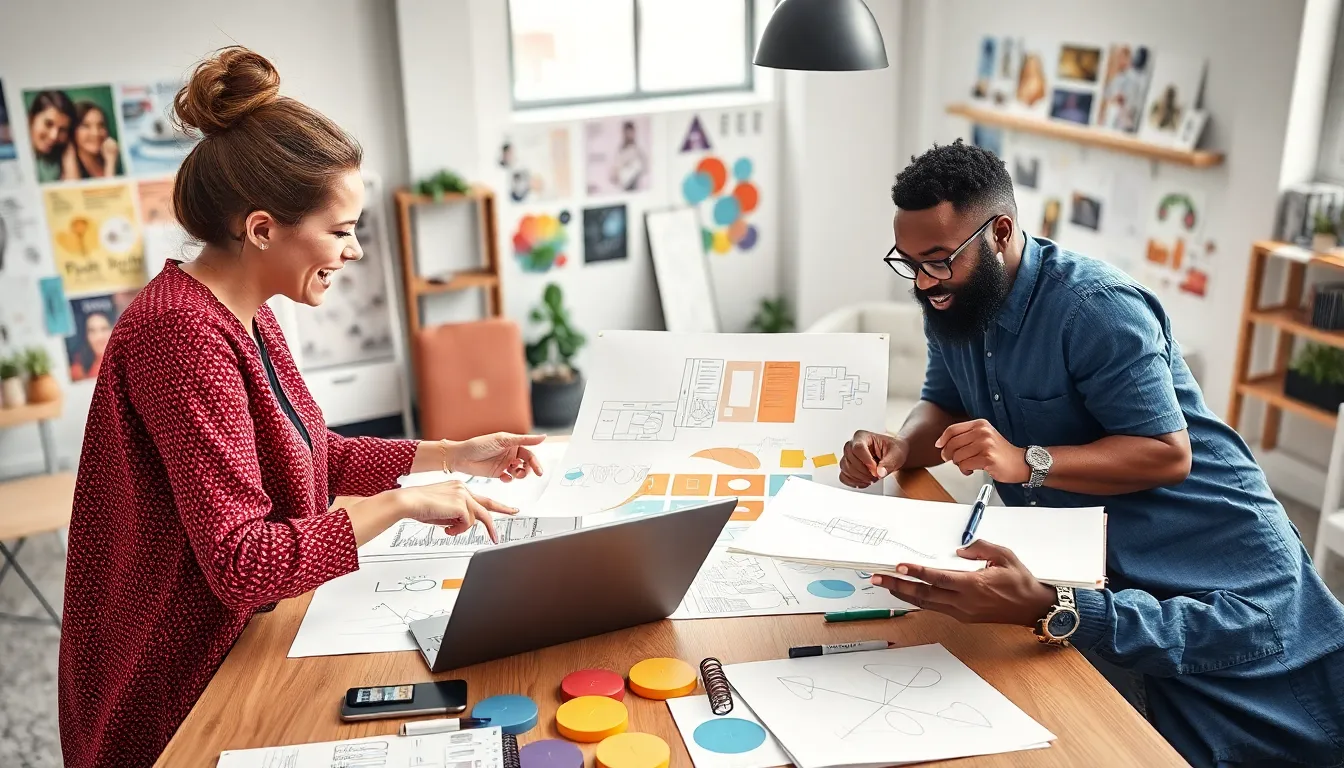Table of Contents
ToggleIn today’s fast-paced world, design collaborations are reshaping the creative landscape. By bringing together diverse talents and perspectives, these partnerships spark innovation and push boundaries. Whether it’s fashion, architecture, or graphic design, collaborative efforts are proving that two (or more) heads are better than one.
As brands and designers unite, they create unique products that resonate with audiences on a deeper level. This synergy not only enhances creativity but also drives engagement and fosters a sense of community. The power of collaboration lies in its ability to blend different styles and ideas, resulting in fresh concepts that captivate and inspire.
Exploring the dynamics of design collaborations reveals how they can elevate projects and redefine industries, making them a vital aspect of the modern creative process.
Overview of Design Collaborations
Design collaborations emerge as a powerful tool in creative industries, enhancing innovation and pushing boundaries. These partnerships consist of professionals from various fields, such as fashion designers, architects, and graphic artists. They work together to merge their unique skills and perspectives.
Collaborative efforts foster creativity by integrating diverse ideas and practices. For instance, a fashion designer might team up with an artist to create a limited-edition clothing line, resulting in a product that tells a compelling story through visuals and craftsmanship. This blending of talents often leads to groundbreaking designs that catch the attention of target markets.
The significance of these collaborations extends beyond aesthetics. Successful partnerships can also enhance brand engagement and reach. Companies that engage in collaborations communicate a message of inclusivity and modernity, appealing to a broader audience. Collaborations often yield products that reflect current cultural trends, making them more relevant and desirable to consumers.
Ultimately, design collaborations play a crucial role in shaping contemporary creative landscapes. By embracing diverse perspectives and combining expertise, these partnerships elevate projects and redefine industry standards.
Importance of Design Collaborations

Design collaborations significantly enhance the creative process, bringing together varied talents to generate innovative solutions. These partnerships are essential in various industries, prompting unique results that appeal to diverse audiences.
Enhancing Creativity
Enhancing creativity occurs when individuals from different disciplines join forces. Collaborations allow for the infusion of fresh perspectives into projects, inspiring new approaches and methodologies. These interactions stimulate brainstorming sessions that often yield unexpected ideas, fostering a culture of experimentation. For example, in fashion, a collaboration between a designer and an artist can lead to collections that feature unconventional patterns and forms, appealing to a broader audience.
Expanding Skill Sets
Expanding skill sets is another crucial benefit of design collaborations. Professionals work alongside experts in related fields, gaining insights and knowledge that strengthen their own capabilities. This exchange of skills fosters personal and professional growth, as team members learn about different techniques and concepts. In graphic design, a partnership between a brand strategist and a visual designer may lead to improved communication strategies, resulting in more effective branding solutions.
Types of Design Collaborations
Design collaborations take many forms, each promoting unique synergies between creative individuals and teams. Two prominent types include cross-disciplinary collaborations and client-designer collaborations.
Cross-Disciplinary Collaborations
Cross-disciplinary collaborations merge talents and viewpoints from different fields. These partnerships often spark innovative ideas that transcend traditional boundaries. For example, a fashion designer may collaborate with an engineer to create wearable technology, resulting in unique products that marry style with function. This fusion of expertise leads to groundbreaking solutions and enhances the overall design process. Partnerships between artists and scientists can also yield environmental designs that focus on sustainability, reaching new audiences concerned with ecological issues.
Client-Designer Collaborations
Client-designer collaborations focus on direct partnerships between clients and design professionals. These relationships promote open communication and shared vision. Clients provide insights into their needs, which designers then translate into tangible solutions. This collaboration enables designers to create customized products that align closely with client objectives. For instance, working closely with a brand allows a graphic designer to develop marketing materials that resonate with the intended audience, ensuring effective messaging. Successful client-designer partnerships foster trust and allow for ongoing adaptations based on feedback, enhancing the project outcomes.
Successful Examples of Design Collaborations
Design collaborations demonstrate the transformative power of merging creativity across industries. The following case studies illustrate successful partnerships that resulted in innovative outcomes.
Case Study: Company A
Company A, a renowned footwear brand, collaborated with a popular streetwear designer. This partnership combined bold aesthetics with functionality, resulting in a shoe collection that became a cultural phenomenon. The unique designs integrated street style elements and high-performance materials, appealing to both sneaker enthusiasts and fashion-forward consumers. Sales skyrocketed, reflecting the collection’s resonance with a diverse audience. This collaboration exemplified how blending different perspectives fosters creativity and expands market reach.
Case Study: Designer B
Designer B, known for sustainable practices, partnered with a luxury home goods brand. This collaboration highlighted eco-friendly design without compromising style. Together, they developed a line of home accessories made from recycled materials. Innovative design techniques minimized waste while maximizing visual appeal. The launch drew significant media attention, raising awareness about sustainable design practices. This partnership showcased how collaboration can redefine industry standards and promote environmentally conscious solutions.
Challenges in Design Collaborations
Design collaborations face various challenges that can hinder their effectiveness and success. Understanding these obstacles is crucial for maximizing the benefits of collaborative efforts.
Communication Barriers
Communication barriers often arise in design collaborations, impacting the clarity of ideas and objectives. Misunderstandings can occur due to differences in terminology or work culture, leading to confusion among partners. Ensuring regular check-ins and establishing clear channels of communication can alleviate these issues. Utilizing tools that facilitate real-time feedback and discussions also fosters a more cohesive workflow. By addressing potential communication gaps, teams can better align their visions and enhance collaborative outcomes.
Conceptual Differences
Conceptual differences can create friction in design collaborations, as team members may approach projects with varying philosophies and methodologies. Diverse perspectives can lead to innovative solutions, but they can also result in conflicts if not managed effectively. Establishing a shared vision at the project’s outset helps unite different ideas toward a common goal. Engaging in brainstorming sessions allows team members to voice their individual concepts while working collaboratively to refine these ideas into a cohesive final product. Recognizing and valuing these differences ultimately strengthens the collaboration.
Design collaborations are transforming the creative landscape by merging diverse talents and perspectives. These partnerships not only drive innovation but also enhance brand engagement and market reach. By blending different styles and ideas, they create unique products that resonate with audiences and reflect current cultural trends.
While challenges such as communication barriers and conceptual differences exist, establishing clear channels and a shared vision can foster successful collaborations. The ability to learn from one another and experiment with new methodologies enriches the creative process. As industries continue to evolve, embracing design collaborations will remain essential for driving progress and redefining standards.




